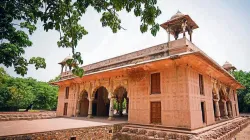Delhi's Mughal-era garden Roshanara Bagh refurbished, here's what has changed
Experience the rejuvenation of Roshanara Bagh, a cherished Mughal-era garden in Delhi, as it undergoes a remarkable transformation with revived features including a restored lake and a modern nursery. Discover the changes that breathe new life into this iconic historical site.

Hidden amidst the bustling streets of North Delhi lies a piece of history that has recently undergone a remarkable transformation. Roshanara Bagh, a 17th-century Mughal-era garden, once neglected and forgotten, has now been revitalised to its former glory, thanks to a concerted effort by the authorities.
At the heart of this restoration project was the revival of the garden's centrepiece – a four-acre lake that had long been a victim of neglect and misuse. After decades of serving as a dumping ground for garbage, this once serene waterbody has been given a new lease of life. Cleared of weeds and debris, the lake now gleams with fresh water, fed by a steady trickle from a nearby water treatment plant.
According to a report by Hindustan Times, a senior Municipal Corporation of Delhi (MCD) official said, “The lake bed was cleared of weeds and excavated. Stone pitching has been carried out along the periphery of the lake. The lake is now fed water by a decentralised sewage treatment plant and channels have been developed along the lake periphery so that rainwater during monsoon gets collected in the water body."
The restoration efforts haven't stopped at just clearing the lake. The surrounding area has been transformed into a picturesque landscape, featuring landscaped walkways, red sandstone shelters, gazebos, and play areas for children. These additions are not just cosmetic; they are part of a larger plan to rejuvenate the entire garden and make it a vibrant public space once again.
Behind this ambitious restoration project lies meticulous planning and execution. The proposal for reviving the lake was first initiated in December 2018, following directives from the National Green Tribunal (NGT). Subsequently, the plan evolved to include a decentralised sewage treatment plant to maintain the water level in the lake. With funding from the central government and support from the Delhi Jal Board's "city of lakes" project, the dream of breathing new life into Roshanara Bagh began to take shape.
One of the most striking features of the rejuvenated garden is the preservation of its historical elements. Roshanara Bagh, named after Shahjahan's daughter Roshanara Begum, holds significant historical importance. The tomb of the princess, along with a 17th-century eastern gateway and a water channel, are among the few surviving structures from its Mughal past. Efforts to conserve these heritage sites have been integral to the restoration project, ensuring that the garden remains a testament to Delhi's rich cultural heritage.
The transformation of Roshanara Bagh is not just about aesthetics; it's also about sustainability. The decentralised sewage treatment plant now serves as a modern source of water for the lake, ensuring its continuous replenishment. Moreover, by collecting rainwater during monsoons, the garden contributes to groundwater recharge, addressing a pressing environmental concern in the city.
Looking ahead, the Municipal Corporation of Delhi (MCD) has ambitious plans for Roshanara Bagh. Boating facilities are set to be introduced on the lake, adding another dimension to the garden's recreational offerings. “A ghat with staircases has been developed at the corner of the waterbody. It is still being excavated to make it deeper. Once the water reaches this point, it can serve as the entry point for the boating section,” the civic official added, as per Hindustan Times report.
The revival of Roshanara Bagh stands as a shining example of what can be achieved through collaborative efforts and visionary planning. From a neglected relic of the past, this Mughal-era garden has been transformed into a vibrant oasis in the heart of Delhi, beckoning visitors to immerse themselves in its rich history and natural beauty. As the garden blooms once again, it serves as a reminder of the importance of preserving our cultural heritage and nurturing our green spaces for generations to come.
ALSO READ: World Forestry Day 2024: 5 Indian forests every nature lover must visit once